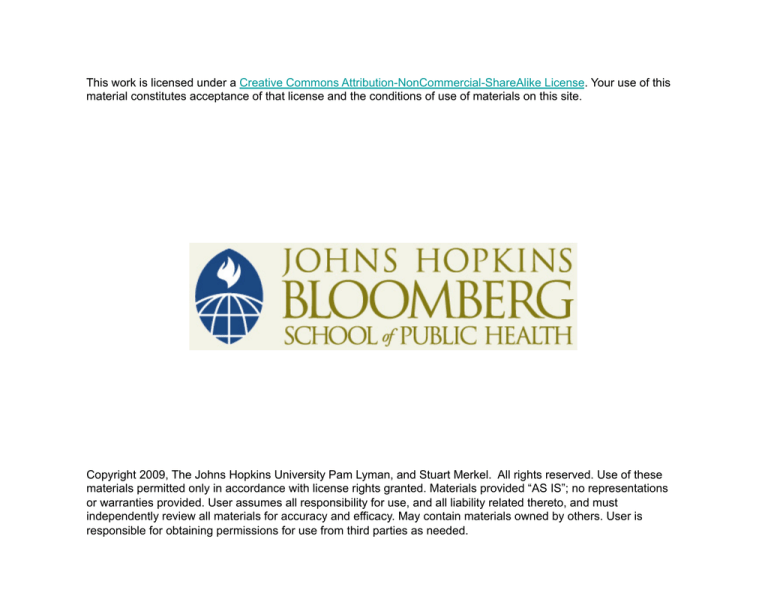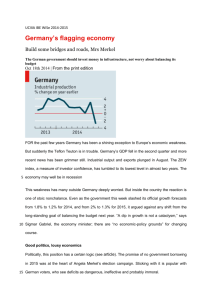
This work is licensed under a Creative Commons Attribution-NonCommercial-ShareAlike License. Your use of this
material constitutes acceptance of that license and the conditions of use of materials on this site.
Copyright 2009, The Johns Hopkins University Pam Lyman, and Stuart Merkel. All rights reserved. Use of these
materials permitted only in accordance with license rights granted. Materials provided “AS IS”; no representations
or warranties provided. User assumes all responsibility for use, and all liability related thereto, and must
independently review all materials for accuracy and efficacy. May contain materials owned by others. User is
responsible for obtaining permissions for use from third parties as needed.
Urban Health in Developing
Countries
Live Talk 2
Urban Health Issues
14 April 2009
2
Overview of Live Talk
• Our course has three planned live talk
sessions
• Each session will be divided into two parts
– First we will have a guest speaker who will
share some experiences
– Secondly we will take questions and
comments from the BBS and respond to them
• As time allows we will encourage
additional questions for our guests and
about the current Module
3
Part 1
Pam Lynam and
Stuart Merkel
Jhpiego – Kenya Program
4
HEALTH IN THE URBAN
SLUMS: Let the people lead the
way
Pamela Lynam MD
Stuart Merkel, MBA
April 2009
5
Photo by Madhav Pai. Creative Commons BY.
6
Jhpiego Overview
Photo by Jhpiego staff.
• A non-profit affiliate of
Johns Hopkins University
• Funded through
governments, international
donors, private
corporations and
foundations
• Strengthens the
performance of health
workers and health
systems to provide quality
health care services in
low-resource settings
• Started in Kenya in 1973
7
Jhpiego’s Work in Urban Slums
Photo by Stuart Merkel.
• Korogocho & Viwandani Slums,
Nairobi, Kenya
• A variety of technical
interventions:
– HIV
– Reproductive Health
– Family Planning
– Safe Motherhood
• Focus on:
– Facility-based improvement in
quality of services
– Community empowerment for
increased access to services
– Community-facility linkages for
8
sustainability
The Facts: Urbanization
• The World is
increasingly Urban
– 3 in 5 people will live
in cities by 2030
– 95% of urban growth
will be in the
developing world,
creating as many as
10 new large cities
each year (UNFPA)
Photo by Stuart Merkel.
9
The Facts: Growth of Slums
• Most urban growth is in informal settlements, or
slums
– 1/3 of urbanites live in slums (=~1.2 billion)
– 72% of African urbanites are slum dwellers. Africa is
the fastest urbanizing continent
– Asia has the largest number of slum dwellers
• 554 million total
• 60% of all slum dwellers worldwide
10
Broad Characteristics of Slums
Poor Health Conditions
• Services:
– Poor access to – and quality of
– health services
• Hazardous Environment:
– Deficient access to water and
sanitation, toilets
– Waste, garbage
Cash-Based Economy: Many
competing factors:
– Example: paying for food,
clothing, shelter vs. health
services
Photo by Stuart Merkel.
11
Nairobi Slums (1)
Insecurity and severe overcrowding
– 60% of Nairobi residents live on
5% of land (slums)
– Land/housing tenure
– Crime and sexual assault
– Heterogeneous populations
Breakdown of social cohesion
– Complex power relationships
– Disruption of traditional family,
Photo by Stuart Merkel.
community & ethnic support
structures
– Prostitution, addiction, domestic
violence, etc.
12
Nairobi Slums (2)
Inadequate Health Services
– Lack of Respect and Trust
+ Insecurity and Neglect
– Illegality and abuse
+ Unhealthy lifestyles
– Breakdown of traditional
structure
– Water and sanitation
issues
____________________________
= Poor Health Indicators
Photo by Stuart Merkel.
13
Nairobi slums - Emerging Evidence
Selected Data:
• Data generally hard to find on health in slums
• Expected higher MMR, prevalence rates for HIV,
TB, etc
14
Two Key Messages
“So Close – Yet So Far”
Proximity ≠ Access
in Slums!
Photo by Stuart Merkel.
Bridging the
CommunityClinic Divide is Key!
Photo by Stuart Merkel.
15
Performance & Quality Improvement
• Originally designed for facility-based programs
– Improve provider performance by focusing on
identified gaps and creating plans to address them
• Adapted for slums context
– Not: “We the experts will give you what you need”
– Rather: “What are your needs? What solutions will
work for you?”
• Health facility level
• Community level
• Jointly
• PQI = empowerment = ownership = sustainability
16
PQI Framework
17
17!
Health Facility interventions
• Built the capacity of health workers from
NCC and NGO/FBO in the informal
settlements in RH/FP.
• Service providers trained in Infection
prevention, CTU, FANC, adolescent
health, reproductive health, FP, HIV
counseling testing, and treatment
• Held meetings with service providers to
create linkages with community
18
Health Facility interventions
• Production of training manuals in RH/FP
• With the cascading approach triple the
service providers trained in all the above
• Supportive supervision for health facilities
19
Community interventions
•
•
•
PQI to define gaps in RH/FP in
community
Orientation workshops for community on
RH/FP
Develop Community Own Resource
Persons (CORPS) in RH/FP
20
Community interventions Cont
• Form Support groups in community for
mother-baby groups
• Assist CBO and FBO in the community to
support this intervention
• Link community to quality Reproductive
health care
• Developed maps and directories for easy
referrals and networking
21
RESULTS
• Improved health /family planning / HIV
knowledge/skills at health facilities
• Increased knowledge on healthcare
services including where to get them in the
community.
• Increased uptake of health services
• Reduced mortality among women due to
unsafe practices
22
PQI Results
Community-Inspired and Owned Interventions
– Anti-rape self defense training
– Community Theatre
– Peer Education
– Community Mapping
– Village Health Committees
– Community Gardening
Photo by Stuart Merkel.
– Free medical camps
– Vastly improved attitude between clinics and
slumdwellers - Painted Health facilities, garden etc.
23
Key Lessons Learned
• Building trust can improve health
– This takes patience and time
• Enthusiasm and energy is
already present in both
communities and among
healthcare workers
• Communities know their health
challenges and must be
consulted when designing
solutions.
• Sustainable results come from
involving all stakeholders
24
Photos by Stuart Merkel.
Implications for Future Projects
• PQI Works!
– Local ownership =
empowerment
• Monitoring and
evaluating PQI
Interventions is
challenging
– Not pre-programmed
– Example: self-defense
• Requires flexibility on
the part of donors and
policymakers
Photo by Stuart Merkel.
25
Acknowledgements
• Communities of
Korogocho and Viwandani
• Healthcare workers in
Korogocho and Viwandani
• City Council of Nairobi
• Rockefeller Foundation
• Wallace Global Fund
• Co-Authors:
– Jane Otai
– Julia Perri
Photo by Stuart Merkel.
26
THANK YOU!
Pamela Lynam, MD
Jhpiego Country
Director, Kenya
Stuart Merkel, MBA
Jhpiego Program
Officer, Kenya
Photo by Stuart Merkel.
27
Visit our Website!
www.jhpiego.org/whatwedo/urbanslums.htm
28
Photos by Stuart Merkel.





